The 10 Best Booths at Frieze Los Angeles

Artsy_The second edition of the Frieze Los Angeles fair kicked off on Thursday at Paramount Pictures Studios, drawing exactly the sort of star-studded crowd one might expect from a major fair staged at a Hollywood film studio. The VIP preview was attended by Oscar winners Leonardo DiCaprio, Charlize Theron, and Natalie Portman; Grammy winners Usher and The Weeknd; Emmy winner Amy Poehler; and many more Tinseltown types. At least one, Kendall Jenner, left with a new acquisition: The model and reality TV star bought one of the new James Turrell works in his “Glass” series, which are being co-presented by Pace Gallery and Kayne Griffin Corcoran.
The fair, which continues through Sunday, features plenty of standout presentations among the 76 participating galleries, not to mention the large-scale installations in the backlot behind the main tent. Here, we shine a spotlight on some of the fair’s best booths in a leading role.
Salon 94
Main Section, Booth A1
With works by Derrick Adams, Lyle Ashton Harris, Laurie Simmons, Amy Bessone, and Thomas Barger
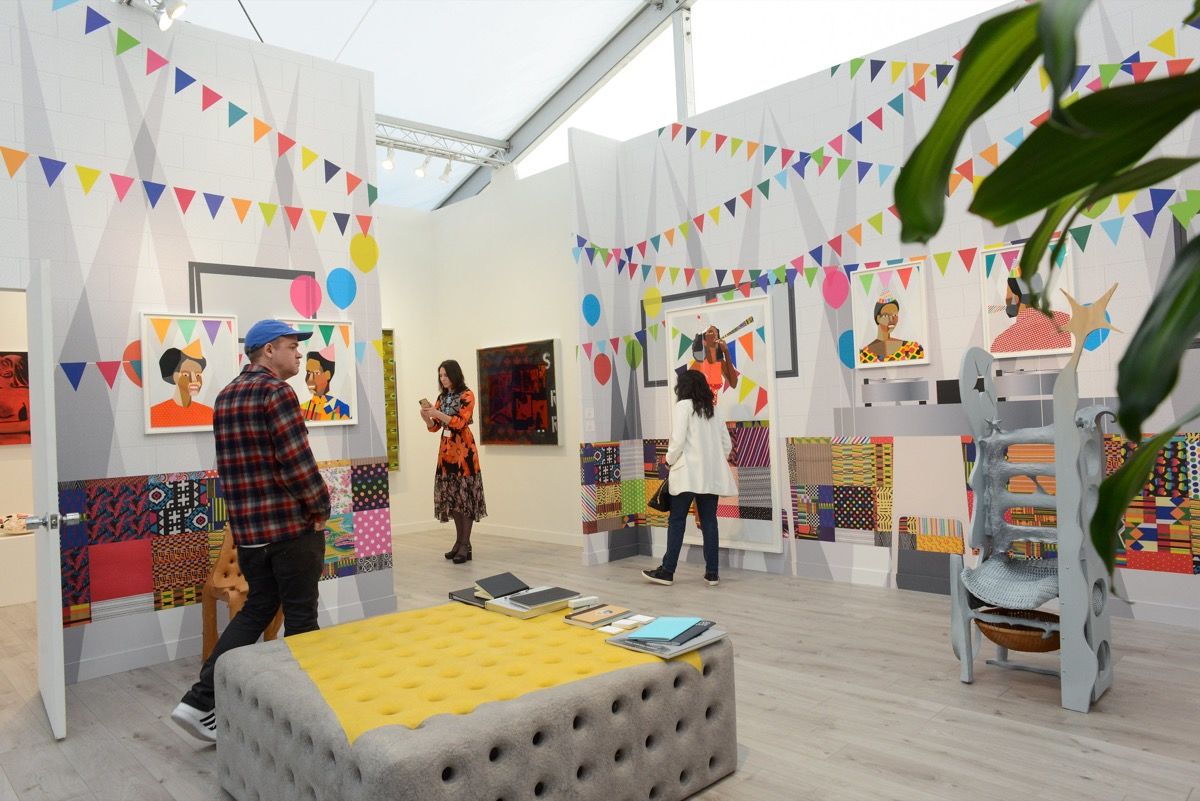
Art fair previews can feel like parties, but even in the few lulls when the Salon 94 booth was empty on Thursday, it still looked like a bash, thanks to a clever installation by Derrick Adams. The indefatigable artist created a custom wallpaper design that turned the booth into a festive scene complete with turntables, garlands, and balloons. His mixed-media portraits of revelers rendered in paint and collage are arranged across the walls of the booth’s main space. Beneath them sit similarly exuberant sculptural seats by Brooklyn-based designer Thomas Barger.
“We haven’t had a show yet with Derrick since he joined the gallery, and we decided this would be a great place to do so,” said Salon 94 director Alissa Friedman (the gallery began to show the artist in collaboration with Luxembourg & Dayan this past September). Friedman noted that while Adams was creating the new work, he conceived of the installation, and then Barger took inspiration from it to develop his pieces. Adams’s works are priced between $35,000 and $120,000, while three new works by Lyle Ashton Harris in the booth’s alcove were being offered at prices ranging from $85,000 to $120,000.
Sadie Coles HQ
Main Section, Booth C4
With works by Alvaro Barrington
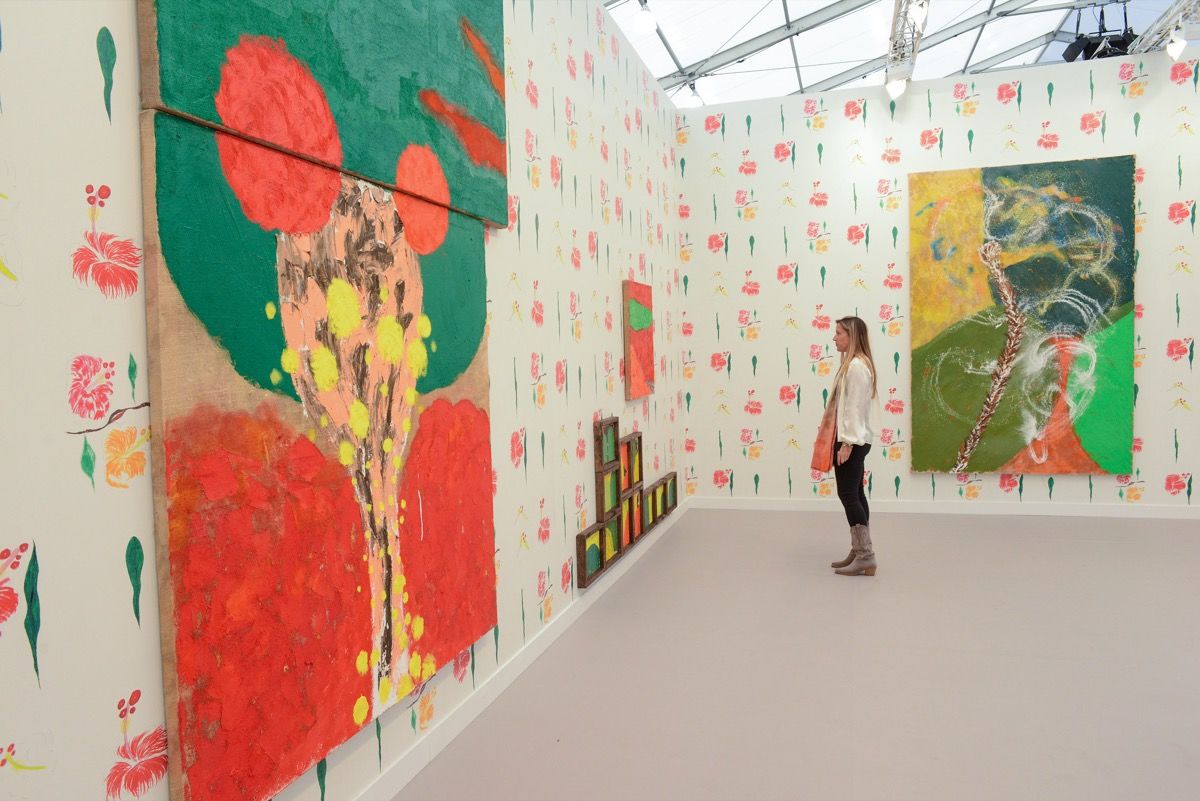
Positioned near the fair’s main entrance, the Sadie Coles HQ booth had a magnetic effect on VIPs arriving Thursday, due in no small part to the irresistible floral wallpaper created for the booth by Venezuelan painter Alvaro Barrington. He also made a series of new paintings for the fair that he finished on-site, many of them taking inspiration from the tropical flora of his childhood in Grenada, according to gallery director Laura Lord. And though she wouldn’t specify the prices of these new works by the sought-after artist, she did note that “the wallpaper is available and for sale by the meter.”
Casey Kaplan
Main Section, Booth C5
With works by Jordan Casteel, Jonathan Gardner, and Matthew Ronay
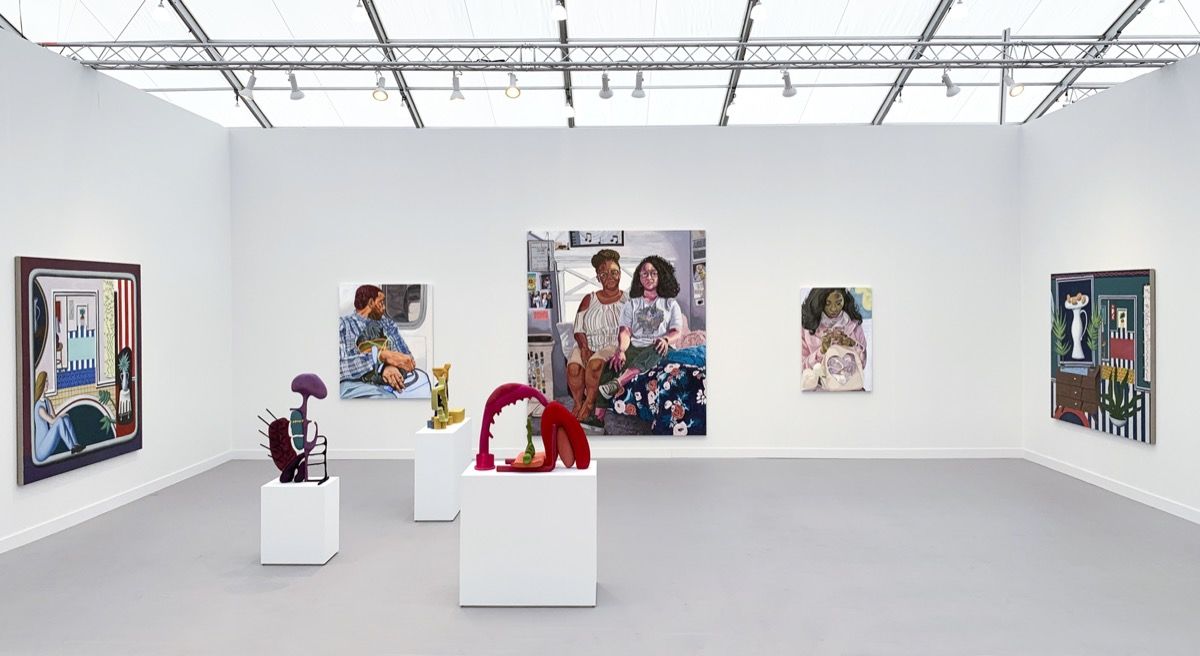
If there’s a dominant medium or aesthetic at Frieze L.A., it’s figurative painting, and New York gallery Casey Kaplan is showcasing two young-ish masters of the form: Jordan Casteel
and Jonathan Gardner. And though their styles are very different, their works hang together attractively, especially with Matthew Ronay’s popping, sensual sculptures serving as punctuation.
“We’ve been trying to focus on smaller, three-artist booths at fairs,” said Rosie Motley, the gallery’s associate director. “For us, it’s about developing regional interest. Frieze L.A. is very different from a fair like Art Basel in Miami Beach; there’s a palpable California regionalism to it.” The gallery’s efforts to curry favor in California paid off—all the works on view had sold by the end of Thursday’s VIP preview. One of Casteel’s paintings was bought by Ari Emanuel, the co-CEO of Endeavor, which owns a stake in Frieze.
Gagosian
Main Section, Booth C6
With works by Jean-Michel Basquiat, Chris Burden, John Chamberlain, Urs Fischer, Theaster Gates, Piero Golia, Alex Israel, Sally Mann, Adam McEwen, Cady Noland, Richard Prince, Sterling Ruby, Ed Ruscha, Taryn Simon, Robert Therrien, Andy Warhol, and Tom Wesselmann
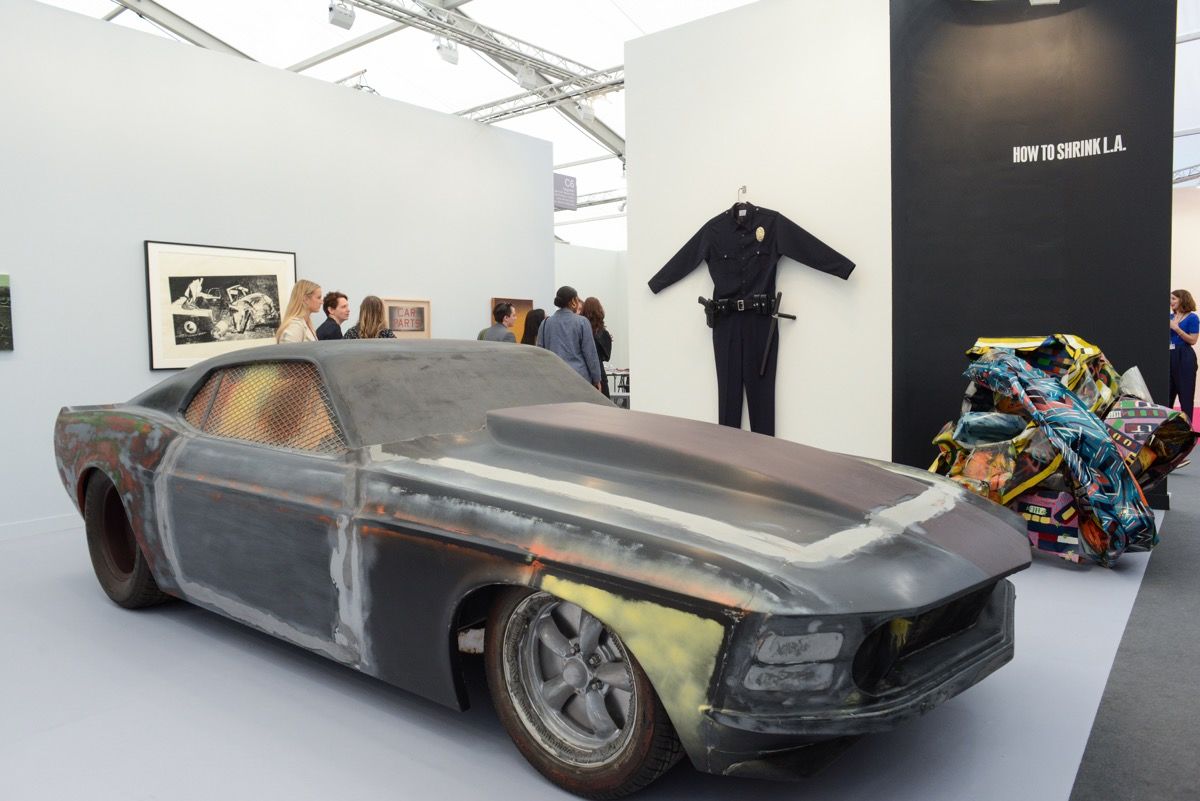
The defining feature of L.A.’s landscape—the car—is also the thematic vehicle powering Gagosian’s bravura booth at the fair. The centerpiece is a 1,600-pound modified Mustang by Richard Prince
. Arrayed around it are other works inspired by car culture and the City of Angels under the title “How to Shrink L.A.,” taken from a 1999 Chris Burden
drawing that is also on view. In addition to a large John Chamberlain
sculpture of elegantly crumpled car bits, the Gagosian booth features thematically apt works by Jean-Michel Basquiat, Alex Israel, Cady Noland, Ed Ruscha
, and others. And while Prince’s Mustang may dominate the space, another large-scale work—an extremely detailed, full-scale sidewalk by the late Robert Therrien
complete with manhole cover and painted curb—is just as likely to cause traffic jams in front of the booth.
Vielmetter Los Angeles
Main Section, Booth D10
With works by Genevieve Gaignard
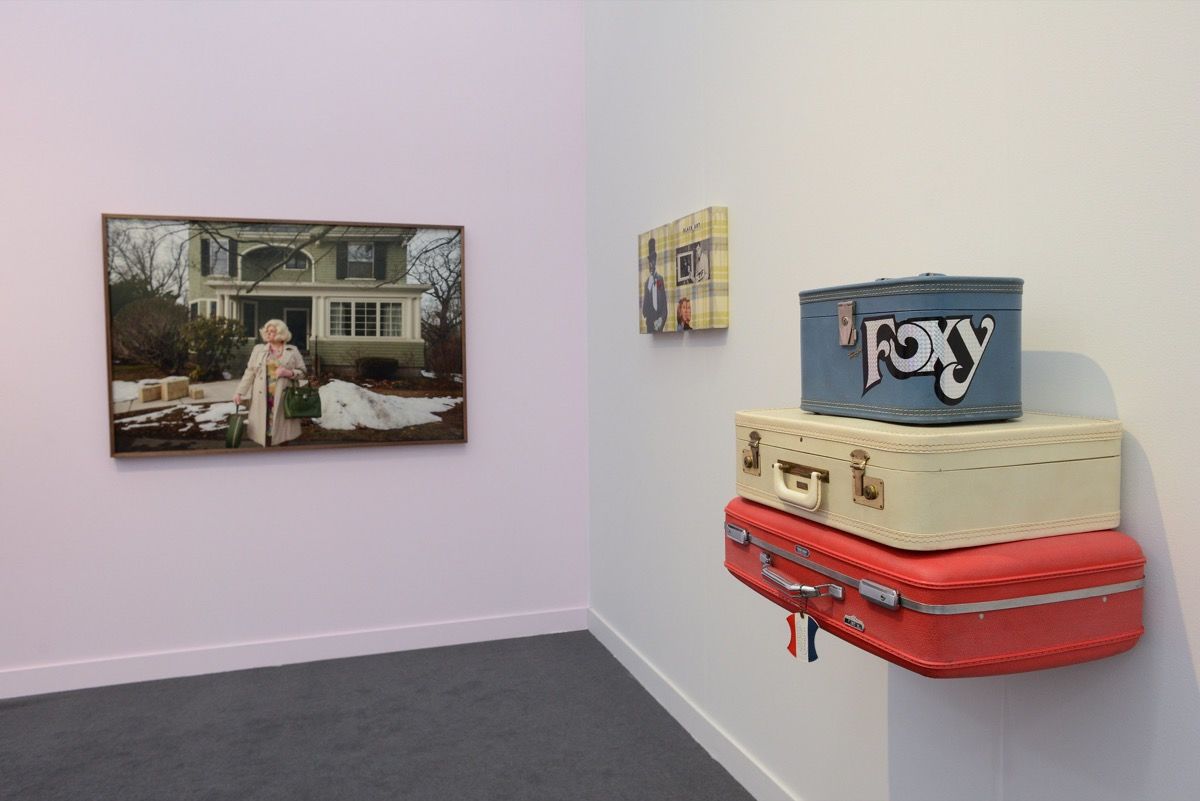
The Vielmetter Los Angeles booth beckons visitors with bright-pink neon letters spelling out “LOOK AT THEM LOOK AT US,” a new work by Genevieve Gaignard that anchors her solo booth. But during Thursday’s preview, the artist herself was standing sentry, wearing a dress that featured an even catchier statement: “SELL TO BLACK COLLECTORS.” While many artists prefer to keep their distance from the unabashed commercial context of art fairs, Gaignard feeds off it.
“It helps me figure out if maybe I didn’t quite get to the place I wanted to get to,” she said. “It’s my mission to ask these difficult questions, but in ways that also create a safe environment to discuss those topics, so people don’t feel accused.” Her works in the booth—a mix of sculptures, photographs, and collages—pose difficult questions about identity and the widespread acceptance of racist imagery through a nostalgic aesthetic Gaignard described as her “grandma persona.” The collages are priced between $10,000 and $24,000; the photographs between $7,000 and $10,000; and the neon work is on offer for $24,000.
Pace and Kayne Griffin Corcoran
Main Section, Booth B16
With works by James Turrell
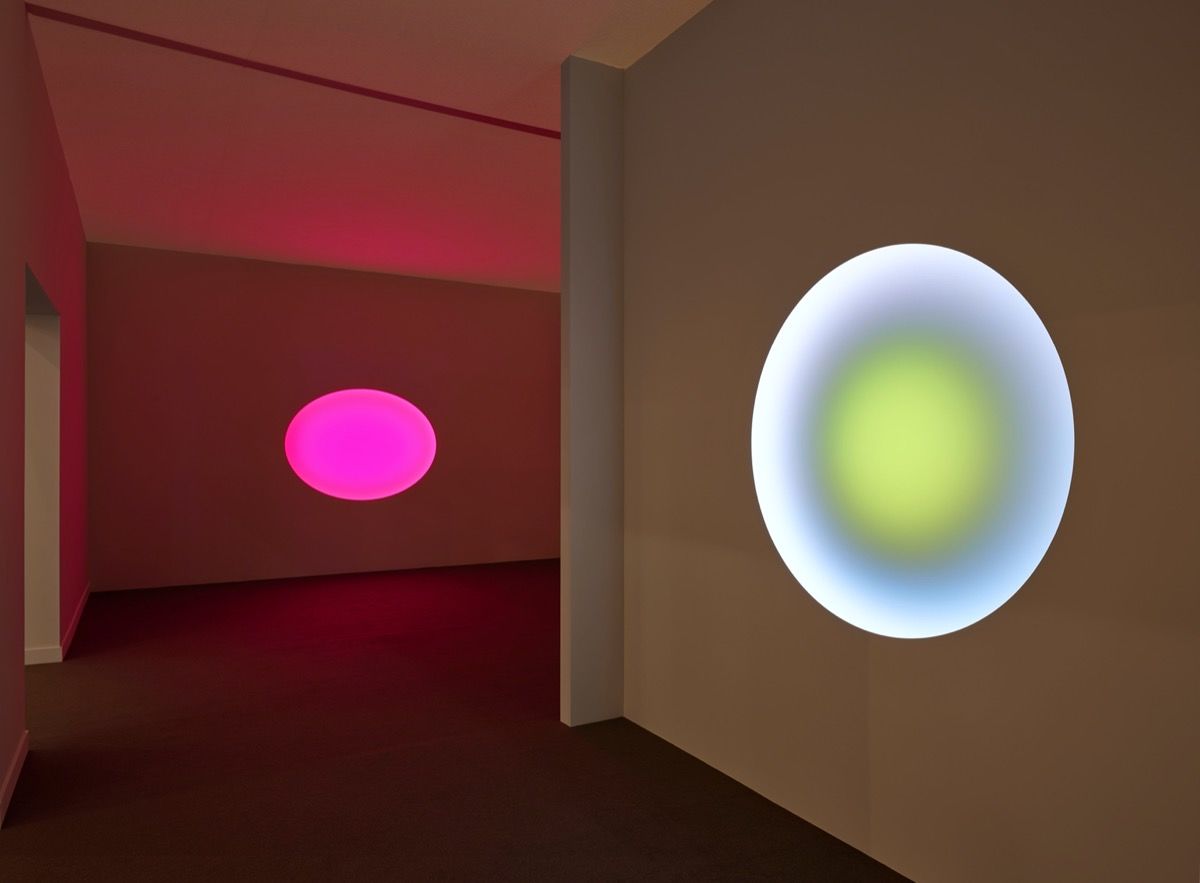
The fair’s most ambitious booth, hands down, is Pace Gallery and Kayne Griffin Corcoran’s joint showcase of new light works by James Turrell. It includes the first ceiling-mounted piece in Turrell’s “Glass” series, which features shallow cutouts outfitted with shifting LED lights. “Since he started working on this series, the technology has gotten a lot more sophisticated, so he can create more ambitious lighting sequences that become essentially like narratives,” said Beatrice Shen, director of sales at Kayne Griffin Corcoran. She noted that each piece cycles through a two-and-a-half-hour sequence of colors. Four of the Turrells had been sold by the end of the day on Thursday, primarily with local collectors, Kendall Jenner being one of them. (The galleries declined to discuss prices for the works.)
The display also sought to raise awareness of and interest in Turrell’s magnum opus, Roden Crater—an open-air observatory the artist has spent decades building inside a collapsed volcano in the Arizona desert. It recently served as the setting for Jesus Is King (2019), the Imax film by Kanye West (who also donated $10 million to the project). Thursday night, the galleries threw a launch party for a Roden Crater crowdfunding campaign; at the event, it was announced that mobile gaming entrepreneur Mark Pincus pitched in a cool $3 million.
Anat Ebgi
Focus LA Section, Booth E2
With works by Greg Ito
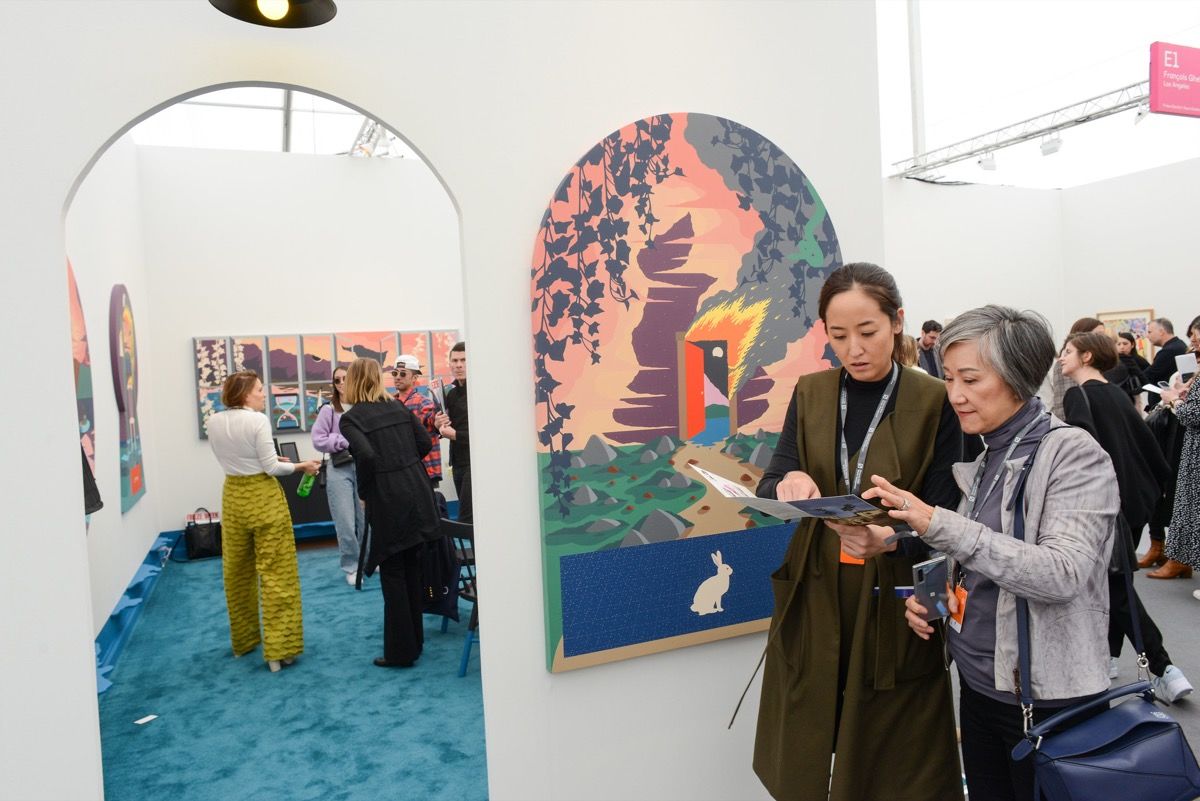
Many of Frieze L.A.’s strongest booths belong to local galleries, and most of those, unsurprisingly, are clustered in the fair’s Focus LA sector, which was overseen by Los Angeles County Museum of Art curator Rita Gonzalez. The most eye-catching of these is undoubtedly Greg Ito’s apocalyptic takeover of Anat Ebgi’s booth. With its blue carpeting and baseboards, the booth evokes a disastrous déluge, which matches the scenes of flooding and fires in Ito’s elegant, ominous paintings.
“They have a kind of dream logic, but they also draw from his heritage, specifically his grandparents’ experience of being forcibly relocated to a Japanese internment camp in Arizona during World War II, which is where they met,” explained gallery associate Amanda McMorran. “There’s a feeling of impending doom in the paintings, which is very of-the-moment, but there’s something hopeful in them, too.” The paintings were priced between $7,500 and $12,000, and by the end of Thursday’s preview, they’d all been sold. Hopeful collectors need not despair: Ito will have a solo show at Anat Ebgi in September, for which he’ll build a burning house in the gallery.
The Pit
Focus LA Section, Booth E5
With works by Jaime Muñoz
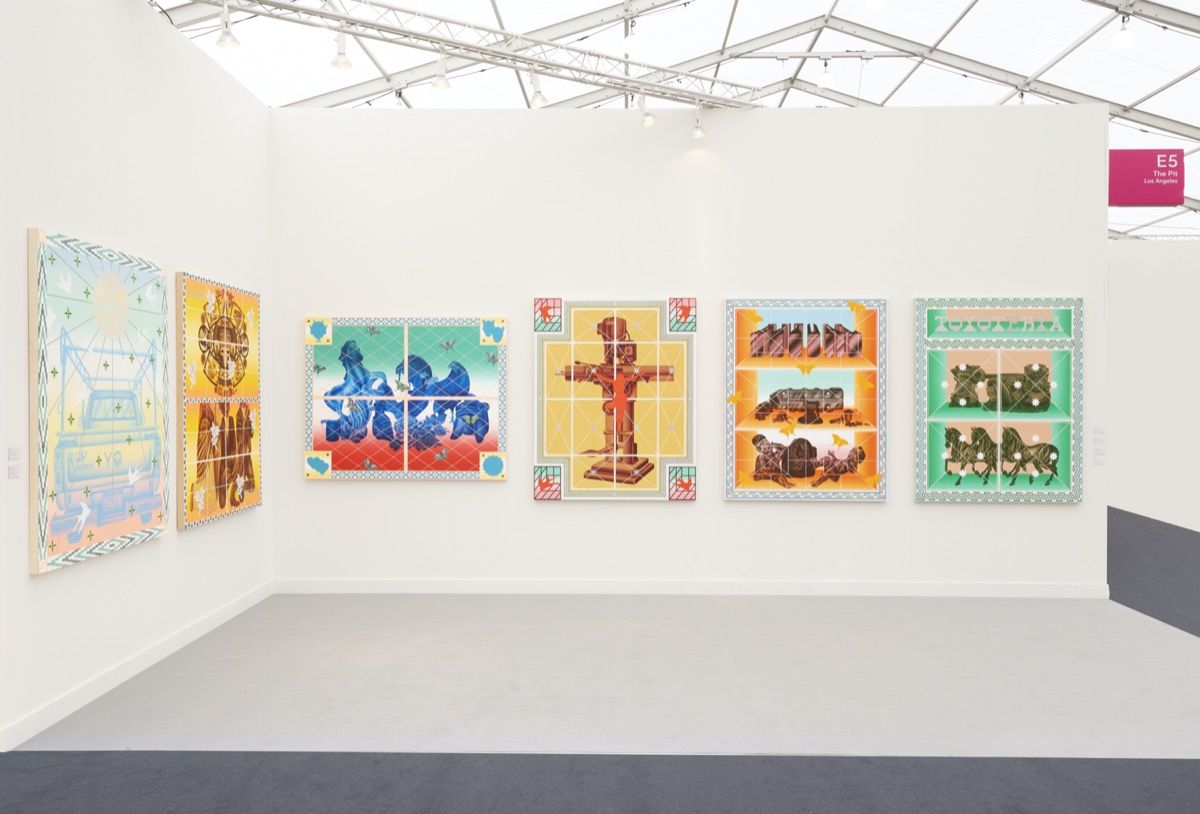
Jaime Muñoz’s dazzling new paintings in The Pit’s booth showcase a mix of techniques and influences, from airbrush, glitter, and flocking to tattoo art, Mesoamerican statuary, and car culture. The results are bold, saturated, and rigorously structured compositions that juxtapose disparate objects and images.
“A lot of the work is about labor and what labor means to him given his identity as a first-generation Mexican-American,” said gallery co-founder Adam D. Miller. “He’s also part of a group called Toyoteria, which is kind of like hot rod culture, but specifically devoted to these workman Toyota trucks. In the paintings, he often compares them to other objects that have a ritualistic, symbolic function.” Collectors were picking up Muñoz’s tributes to Toyota pickup trucks during Thursday’s preview; by Thursday afternoon, The Pit had sold all but one of the paintings, which were priced at $9,000 apiece.
Commonwealth and Council
Focus LA Section, Booth E10
With works by Young Joon Kwak and Oren Pinhassi
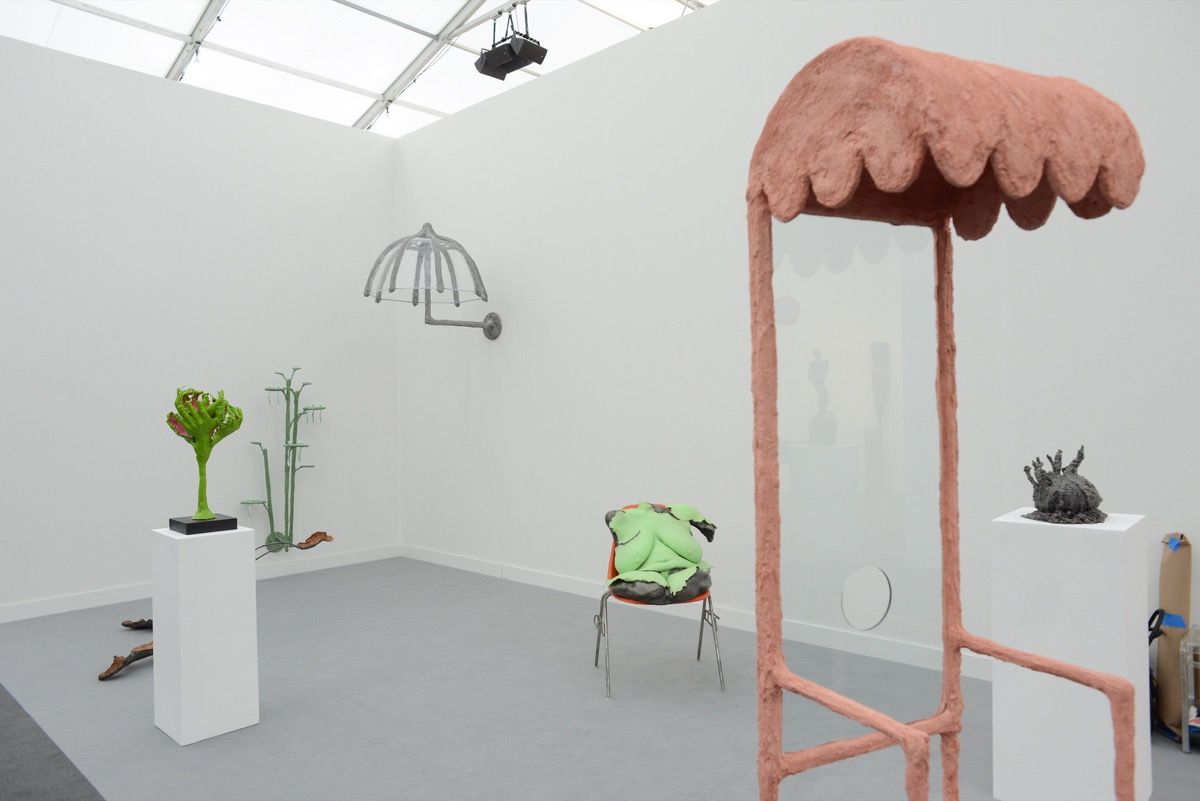
L.A.’s Commonwealth and Council brought in the tag team of sculptors Young Joon Kwak and Oren Pinhassi for the sixth iteration of its tribute to the women’s wrestling league Gorgeous Ladies of Wrestling (now the subject of a popular Netflix series). The featured works, which the artists selected in consultation with one another, center bodies of all sizes and sorts. In Pinhassi’s work, this can be quite irreverent, like a sculptural walker outfitted with an awning and a glory hole. Kwak takes a more direct approach, such as a work featuring a nude female torso seated on a Herman Miller chair, or a riff on Constantin Brancusi featuring spiky protrusions cast from the insides of fleshlights.
“Oren’s work is about sites where private activities come out in public,” said gallery director Irina Gusin, “while Young Joon is reacting to these narratives from art history that use women’s bodies as passive vessels.”
